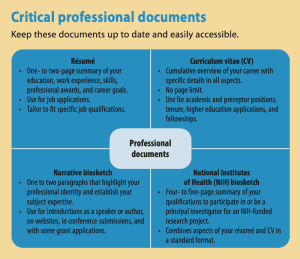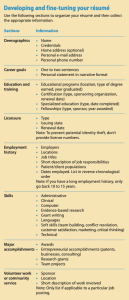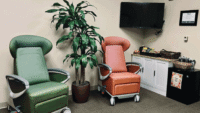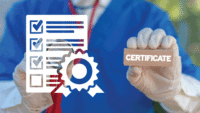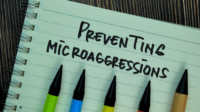Stand out from the pack by tailoring your résumé to specific positions.
In addition to your nursing license, you should have several documents on hand to establish your professional identity. They include a résumé, curriculum vitae, narrative biosketch, and a National Institutes of Health (NIH) biosketch. Each serves a unique purpose and requires a different format. (See Critical professional documents.)
A curriculum vitae (from the Latin for “course of life”) serves as a cumulative description of your career. It should contain details of your education, work positions, presentations, publications, professional memberships, committee involvement, awards, scholarships, research projects and interests, academic courses created and taught, community service, and volunteer work. Nurses typically use this document for academic and preceptor positions, tenure, application to higher education programs, and fellowships. Its length depends on the content.
A narrative biosketch describes your professional experience and highlights your expertise. At one to two paragraphs, this document can be used to introduce you as a speaker or author, to describe yourself on websites or at conferences, and to submit with some grant applications. You can adapt it based on the topic.
An NIH biosketch is a standardized four- to five-page form used for NIH grant applications. It combines information from your résumé and curriculum vitae. (For information about how to format an NIH biosketch, visit grants.nih.gov/grants/forms/biosketch.htm.)
Résumé comes from the French word meaning “summary,” and it’s probably the most useful professional document for any nurse to have. Because a résumé summarizes your career, you should limit it to one to two pages. Knowing how to create, individualize, and polish your résumé can aid your ability to stand out among other job applicants.
Creating a résumé
Most job postings require that you submit a résumé. Many employers use an online applicant tracking system (ATS) that sorts through applications and résumés to help them select candidates who best fit the position they’re looking to fill. For this reason, you may need several versions of your résumé based on the type of positions you seek. For example, you may have experience in both community health and pediatric nursing, so your submitted résumé should reflect the experience most important for a particular job posting. Or you may want to highlight your foreign language skills or computer expertise for certain positions.
Remember that your résumé makes a first impression to potential employers. Take time crafting it to ensure you get the employer’s attention.
Do your homework
If you’re creating your résumé from scratch, start by listing your education, certification and license information, employment history, skills, major accomplishments, and volunteer or community service work. Next, search for articles or online sources for suggestions on what information to include. Look at examples and templates of résumés for formatting ideas. Finally, ask colleagues to share their résumés so you can see how others have highlighted their careers. (See Developing and fine-tuning your résumé.)
Review the job posting
Now that you have all the necessary information collected, take a close look at the job posting and highlight key words or phrases, including required and preferred qualifications. Match your skill set, work experience, and education to these key words or phrases. Incorporate these key words into your résumé so an online ATS program will identify them and select you as a viable candidate.
Formatting tips
Below are some tips for formatting your résumé:
- Limit your résumé to one to two pages.
- Use standard 1-inch margins.
- Use 11- or 12-point Times New Roman, Arial, Garamond, or Helvetica fonts.
- Use bold font headings to organize content.
- Use standard bullet points and write succinctly.
- Write in the third person as though you’re describing someone else (avoid first person pronouns).
- Use reverse chronological order for educational and work experience (for example, start with your most recent position and work backwards).
- Use action verbs (developed, created, implemented, etc.).
- Leave plenty of white space on the page so your résumé is easy to read.
- Avoid abbreviations and acronyms.
- Don’t use fancy templates with unusual fonts, graphics, or pictures.
- Save your résumé as a PDF to ensure the ATS can’t change the format.
- Place a date stamp in the footer and save it on your computer.
What to include
At the top of your résumé place your name, credentials, and contact information. Use your personal email and phone number (not work). Ensure your email address sounds professional. For example, if your email address is catlover@xxx.com, consider changing it. You may or may not want to include your home address.
Order your headings based on what you want to highlight. For example, if the job requires a masters degree, highlight your education first.
Education. List the education programs you’ve attended in reverse chronological order. Include locations, types of degrees earned, and dates of graduation. If you haven’t graduated yet, note your anticipated graduation date. If you have a certification relevant to the position, include the type, sponsoring organization, and renewal date. If you have job-related specialized training, such as pediatric advanced life support, include it with the type and completion date. Finally, if you had or currently have a fellowship, list it with the sponsor and date awarded. If space is limited, you can trim this section to the most relevant information.
Licenses. If the job requires you to have a nursing license, make this a separate section. List the types of licenses you have, the states where they were issued, and their renewal dates. Note whether you have a multistate license. To prevent potential identity theft, don’t include your nursing license number on your résumé. Employers will check your license status prior to offering you a job.
Employment history. Many nurses stumble over the employment history section. In general, you only have to list employment for the past 10 to 15 years. In reverse chronological order, similar to the education section, record the employer, location, job title, short description of job responsibilities, patient/client population served, and dates employed for each position. If you had more than one job with an employer, indent these under that employer’s name and location. Use the job description from each position to help you write a short narrative. As appropriate, incorporate key words or phrases from the job posting into this section.
Skills. Use this section as an opportunity to shine. What skills have you accumulated over your career? Do they demonstrate the direction your career is heading? Think about the technical and clinical skills you have, as well as the soft skills, and highlight your proficiency. For example, you may be fluent in English and Spanish, able to communicate using sign language, and also competent in reading and writing French. If the job requires computer skills, list all of the programs you know. For soft skills, such as team building or marketing, provide examples that demonstrate your expertise.
Major accomplishments. If space allows, include major accomplishments. For example, list any awards you or your team received (innovator award, Daisy award), participation in team projects (risk management improvement, customer outreach), involvement in a research grant and your contribution, and entrepreneurial accomplishments (patents, consulting).
Community service. If it’s applicable to the job posting, you may want to include a heading for community service or volunteer work. For example, you may currently work in an adult rehabilitation setting but volunteer as a camp nurse and want to apply for a school nurse position. Your experience with children at the camp highlights your interest in making a career change.
A few don’ts
You’ll want to avoid including a few things on your résumé. Because references take up space, you can list them on a separate page or note at the end of the document that they’re available upon request. Avoid using slang (which may be viewed as unprofessional) and abbreviations and acronyms (which may be unfamiliar to some or not recognizable by the ATS). Some nurses like to include hobbies, but unless they’re relevant to the job, they only take up valuable space. If you have employment gaps (for example, as a result of childbirth, personal health, family matters) review the advice from the Columbia University Center for Career Education (careereducation.columbia.edu/resources/how-explain-employment-gaps). Most important, never falsify or exaggerate your education, experience, skills, or accomplishments.
Improve your chances
To improve your chances of success in job hunting, take the time to create a professional résumé tailored to fit specific positions. Incorporate key words and phrases from the job posting into your résumé so online ATS programs will highlight your application and increase the likelihood you’ll move on to the next step—an interview. Routinely review your résumé and create a file with updated information to add. Keep all versions of the document so you can quickly access them if and when the need arises.
Debra A. Wolff is president/chief executive officer of Nurses – Ready for the Next Step, author of Advancing Your Nursing Degree: The Experienced Nurse’s Guide to Returning to School, and an adjunct professor of nursing at SUNY Empire State College in Saratoga Springs, New York.
References
Brooks BA. Resume, CV, or both? Nurse Leader. 2021;19(2):120-1. doi:10.1016/j.mnl.2021.03.002
Hicks RW, Berg JA, Roberts MEE. Business documents of the advanced practice registered nurse: Curriculum vitae, resume, and biosketches. J Am Assoc Nurse Pract. 2020;32(9):610-5. doi:10.1097/JXX.0000000000000453
White KA. Resume makeover: Be sure your resume makes an effective first impression. Am Nurse Today. 2018;13(12):68-71.
Worman D. Coaching on resume development and interview preparation for nurses desiring career progression. J Contin Educ Nurs. 2021;52(11):502-4. doi: 10.3928/00220124-20211008-04


